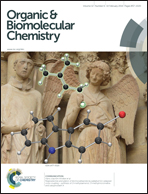Synthesis and characterisation of novel o-xylene-based P,E ligands†
Abstract
A range of novel hybrid ligands of the type, o-C6H4(CH2PBut2)(CH2E) (E = P(C6F5)2, SBut, SPh, S(O)But, NR2, SiPh2H), have been synthesised in two or three steps from the common substrate, o-C6H4{CH2PBut2(BH3)}(CH2Cl). The initial step involved treatment of the substrate with the appropriate nucleophilic reagent, or preparation of a Grignard reagent from o-C6H4{CH2PBut2(BH3)}(CH2Cl) and reaction with the appropriate electrophile. In most cases, this versatile strategy produced air-stable crystalline ligand precursors. Phosphine deprotection was achieved via one of three methods, dependent upon the properties of the second functional group. An alternative synthesis of the known ligand, o-C6H4(CH2PBut2)(CH2PPh2), is also presented.


 Please wait while we load your content...
Please wait while we load your content...